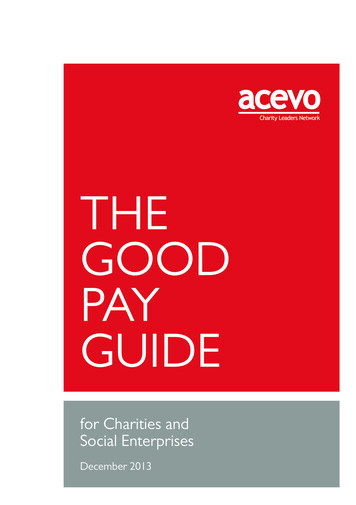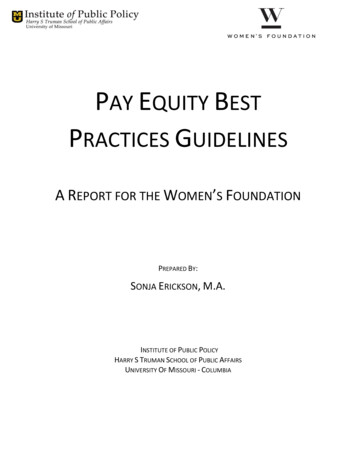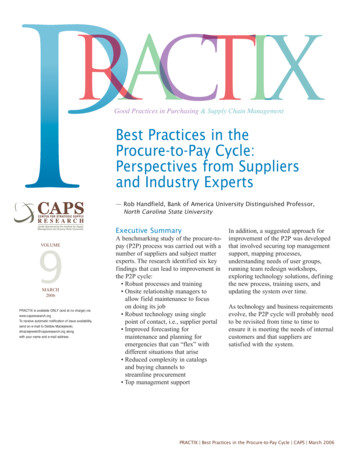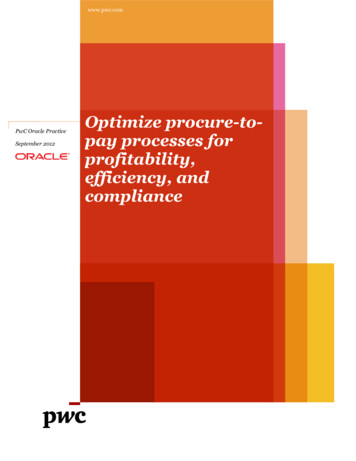
Transcription
THEGOODPAYGUIDEfor Charities andSocial EnterprisesDecember 2013
ForewordBy Lesley-Anne Alexander CBE,Chair of ACEVO and CEO of RNIBFor years the charity sector hasbecome more complex and moreprofessional as we bring our servicesto many more beneficiaries andcauses across the country. In manycases these changes have goneunnoticed and the challenge ofwhat it means to run a twenty-firstcentury charity has remained out ofthe public eye. Guidance for trusteesand remuneration committeesremains thin on the ground.That is why it gives me greatpleasure to welcome ACEVO’sGood Pay Guide for Charities andSocial Enterprises. For more thantwo decades, the annual ACEVOPay Survey has acted as the essentialreference on executive pay in largercharities and voluntary organisations.The 2013/14 Survey added weightto the sector’s ongoing drive to betransparent about pay levels. It alsohighlighted the need to continuetackling inequalities including theregional and gender differences inChief Executive pay. The exciting thingabout this guide is that it is a practicaltool and reference documentfor trustees and remunerationcommittees grappling with thequestion of how to deliver valuefor money for beneficiaries, donorsand staff. I hope that this useful toolwill, in time, become established asa similarly well-respected statementof best practice on the transparencyand good governance necessarywhen setting Chief Executive pay.Readers will know that this Guideshould be merely the beginning of awider public conversation. I welcomethis debate as an opportunity toshine a light on the great work ofcharities up and down the countryand I hope these principles will beadopted as best practice right acrossthe sector.Lesley-Anne Alexander CBEDecember 2013
IntroductionToday’s charity and social enterprise sector is a huge contributor to oureconomy. The sector employs around a million people and turns over 38bn each year.1 Yet with increased responsibility and organisationaldiversity has come increased scrutiny. And during this time perhaps noissue has been more contentious than that of senior executive pay.At the heart of this question is a growing debate: how doesprofessionalism sit alongside the non-profit ethos and public servicevalues that define the sector?At ACEVO we believe that professionalism does not conflict with thevalues that lie at the heart of charities. We see good management,good staff and good values as mutually reinforcing. Experience showsthat committed, professional charity employees, with the support oftheir boards, produce exceptional outcomes for the beneficiaries andcauses that they serve. And good, strong leadership is essential to highproductivity throughout an organisation, whether that sector is public,private or charities and social enterprise.This short guide aims to help boards ensure that employee pay bestserves their charitable aims and objectives. It focusses on five principlesof good pay for charities and social enterprises.31. UK Civil Society Almanac 2012 (NCVO), available at http://data.ncvo.org.uk/
The Five Principles of Good Pay1. TRANSPARENCYBeing open about how pay is set2. PROPORTIONALITYBeing fair and consistent3. PERFORMANCEEnsuring that the salaries you pay workfor your organisation and the beneficiariesyou serve4. RECRUITMENT &RETENTIONKeeping valued staff within theorganisation5. PROCESSEnsuring that the principles of Good Payare supported by appropriate proceduresand policiesAt ACEVO we believe good pay means that boards, beneficiaries, supporters andemployees agree that it provides value for money. We hope that our five principles ofgood pay will help to guide charities and their trustees considering these complex issues.Context: The challenge fora diverse sectorA third of respondents to a recent opinion poll felt that charity chief executivesshould not be paid at all.1A This suggests that many people retain a traditionalperception of charity as the preserve of unpaid volunteers. However, this viewdoes not reflect the breadth and scope of the third sector as it exists today.There are over 163,361 registered charities in the UK, carrying out a vast rangeof different activities and varying enormously in size and scope.2 The range of thesector extends from national or international organisations turning over hundredsof millions of pounds per year, to small charities and community organisationsoperating on minimal budgets.41A. harity-staff-pay 2. NCVO,UK Civil Society Almanac 2012 (2012), http://data.ncvo.org.uk/ [Accessed 12December 2013].
The large majority of charities are clustered at the smaller end of the scale: 42% of registered charities have an annual income under 10,000 fewer than 25% have an annual income of more than 100,000.3120K30%100K25%80K20%60K15%5%20K% ORGANISATIONSCEO SALARY( )Log. (% OF ORG)Expon. (CEO SALARY)10-1920-4950-99100-199200-4950 90-9991000 10%40KMEDIAN CEOSALARY( )35%1-9% ORGANISATIONSVery large charities will have significantly different staffing requirements totheir smaller counterparts, and a very different level of resource to fund staffremuneration. There is, consequently, a close correlation between organisationalturnover and senior staff pay levels. The most recent ACEVO Pay Survey showsthat median chief executive salary usually reaches the 100,000 level when thenumber of employees reaches 1,000 (not including volunteers).4No. OF EMPLOYEESChief executive pay correlates closely with charities’ revenue levels. Median CEOsalary is only 34,600 for charities turning over less than 150,000 a year, whereasthe median exceeds the 100,000 threshold as charities reach an annual revenueof 25-50 million. Similar variations can be found between charity sub-sectors: themedian CEO salary at sports charities was 78,858 (the highest median) comparedto 49,000 for religious charities.5This level of diversity presents a challenge. It is impossible to apply ‘one-size-fits-all’structure on senior staff remuneration across the whole of the voluntary sector.That’s why this guide aims to set out the principles that should inform trustees’thinking during the decision-making process.3. tyPayhaveyoursay [Accessed12 December 2013]. 4. ACEVO Pay Survey 2013/14, m 21& nccspID 1103 [Accessed 12 December 2013].5. ACEVO Pay Survey 2013/14.5
Principle 1: TransparencyTransparency is the first principle of good pay and is crucial if the voluntary sectoris to retain public trust. The Edelman Trust Barometer, a yearly publication fromthe eponymous public affairs firm, shows that charities and social enterprises areconsistently ranked among the most trusted organisations across various sectors. Thisis the case in many different countries, and it has remained relatively constant throughtime.6 However, maintaining that trusted status demands increasing openness fromcharities, no matter how established they are. Charities need to move with the times.Given the high profile attached to senior executive pay in any walk of life, andthe potential for such decisions to provoke public misunderstanding and anger,transparency in relation to how remuneration levels are set is essential to goodpractice. Lack of openness around corporate governance can erode trust in anyinstitution. Indeed, charities should welcome transparency and debate, and thelight this sheds on their work.7The Mechanics of TransparencyTransparent governance for charities requires that, so far as possible, theorganisation’s decisions, activity, strategy and processes are open to all. They mustbe accessible and understandable by beneficiaries, funders and donors, employeesand volunteers, and the general public.Transparency will be achieved by clear and frequent communication with allstakeholder groups. It is the responsibility of charity boards, working in conjunctionwith senior management, to foster an organisational culture of transparency andopenness, and to ensure that the necessary mechanisms are in place to support itin practice.At minimum, these mechanisms should include: Easily-accessible and well-promoted corporate information, An easily-accessible corporate plan, Clear articulation of how the value for money of executive pay is assessed, and Where collaboration supports charitable objectives and does not contravene the corporateplan, the presumption that it should be carried out openly with other organisations.66. Edelman Insights, Edelman Trust Barometer 2013. d 1 December 2013]. 7. Wikipedia, ‘United Kingdom parliamentaryexpenses scandal’. http://en.wikipedia.org/wiki/United Kingdom parliamentaryexpenses scandal. [Accessed 10 December 2013]
Charity boards must also be aware of the differing expectations of different audiencesand groups. For example, with funders and the general public, transparency demands that: Procedures for setting pay are made publicly available for scrutiny, Executive salaries, (either precise figures or in bands) are published, The lowest salaries in the organisation, and the ratio between highest andlowest pay, are easily accessible, and, The charity’s outputs and impact are reviewed and a decision is taken onhow they are published.With beneficiaries, transparency additionally demands a meaningful dialogueand consultation on service levels and quality. With employees, transparencyadditionally demands that they have access to corporate governance proceduresand other corporate information. Trustees are ultimately responsible for a charity’sgovernance – and the setting of pay – so it is in their interests to be prepared to betransparent about their decision-making.CASE STUDY 1:Christian Aid – communicating the CEO’s valueIn August 2013, in response to media criticism of foreign aidcharities, Christian Aid published a press release detailing how andwhy their Chief Executive, Loretta Minghella OBE, receives hersalary.The publication was particularly effective in outlining therole of the organisation’s Chief Executive, and their policy ‘of notpaying higher salaries than are necessary and/or reasonable’.8It also outlined: A summary of how the Board of Trustees set pay The Chief Executive’s previous experience that made hersuitable to the role How many other Directors receive large salaries A summary of how executive salaries are regularly benchmarkedagainst the sector, against external guides to fair pay, and againstother economic indicators such as average weekly earnings andthe consumer price index.We suggest that this type of document is routinely published bylarger, more complex charities - not just in their annual report and that every effort is taken to draw public attention to it.8. Christian Aid, ‘Comment: Loretta Minghella’s salary 2012/13’ (August 13.aspx [Accessed 10 December 2013].7
Principle 2: ProportionalityWhat is proportionate pay? It is a contentious question, especially in the voluntarysector. Charity workers cannot point to record sales or growing profit marginsto justify their remuneration. Any discussion of proportionality in the voluntarysector requires an understanding of the diverse and complex range of activitiesthat charities undertake, and of the importance of talented and experienced staffto the fulfilment of charities’ public benefit objectives.The enormous diversity of the voluntary sector makes it difficult to issue blanketguidelines as to what constitutes ‘proportionate’ pay.So where should a trustee go for guidance? A good principle on remuneration isfound in the Financial Reporting Council’s UK Corporate Governance Code:“Levels of remuneration should be sufficient to attract, retain andmotivate directors of the quality required to run the companysuccessfully, but a company should avoid paying more than isnecessary for this purpose. A significant proportion of executivedirectors’ remuneration should be structured so as to link rewardsto corporate and individual performance.”“There should be a formal and transparent procedure fordeveloping policy on executive remuneration and for fixing theremuneration packages of individual directors. No director shouldbe involved in deciding his or her own remuneration.”9Clearly, it is less simple to reward performance in a non-profit organisationthan in a private company. However, charities should ensure that remunerationlevels are linked to a regular and objective system of performance appraisal, andbenchmarked against comparable roles.89. Financial Reporting Council, The UK Corporate Governance Code (September2012), e-governance.[Accessed on 10 December 2013]. p. 7.
The Mechanics of ProportionalityA clear policy on proportionate pay will be useful to trustees when respondingto public queries. One such example is the international development charityCAFOD, which is examined in the following case-study.Trustees have three main measures to evaluate the proportionality of theirsalaries: comparison within the organisation, comparison within the sector, andcomparison versus similar sectors.A) Within the organisationSenior executive pay will generally be linked to that of other directors. It will beset after considering organisation turnover, number of employees, in-job risk, payof other directors and any other benefits and incentives (for example pensioncontributions).The charity sector is notable for relative equality between its highest- and lowestpaid employees. Comparing the median pay of ACEVO members - 60,000 in thelatest ACEVO Pay Survey - to the UK living wage as set annually by the Centrefor Research in Social Policy at Loughborough University, it may be estimated thatorganisational pay ratios in charities with Chief Executives are typically between3:1 and 5:1.10This contrasts favourably with ratios in other sectors such as universities (nationalaverage around 18:1)11 and local government (national average around 15:1), andvery favourably with large corporations like the FTSE 100 (whose average in 2011was 262:1).The Hutton Review of Fair Pay emphasised the value of annually publishing theratio of top-to-median pay. It concluded that a statutory cap on pay ratios in thepublic sector would be counterproductive, due to the diversity of organisationsaffected.12 It thus drew a very similar conclusion to ACEVO: good pay meansvalue for money, transparently set and communicated, and so it is different inevery organisation.10. The UK Living Wage (outside London) is currently set at 7.65 per hour, whichequates to 13,923 per annum for a 35-hour week. It is updated annually by theCentre for Research in Social Policy at Loughborough University. 11. The Fair PayCampus Report 2013, http://fairpayunis.wordpress.com/ [Accessed 10 December2013]. 12. Hutton Review of Fair Pay in the Public Sector: Final Report (March2011). 110402/http:/www.hm-treasury.gov.uk/d/hutton fairpay review.pdf [Accessed 10 December 2013].9
B) Within the sectorMany large charities may ‘benchmark’ their executive pay against trends such asthose identified in the ACEVO Pay Survey. This survey has been published formore than two decades, and includes a comprehensive summary of CEO salariesand how they vary according to organisation size and type, alongside extensiveinformation on good governance and the backgrounds from which CEOs aredrawn.In addition, boards may wish to supplement benchmarking data with morecurrent data drawn from recruitment consultants or headhunting agencies.Benchmark data is usually slightly out of date due to the data collection methodsused. Recruitment agencies are likely to have access to the latest market ratesfor comparable roles within the sector, so boards may wish to make use of thiswhen using an agency.C) Other comparable sectorsPay is often set not only according to the dictates of the organisation, and the jobmarket in the sector, but also with consideration of average senior pay in othercomparable sectors.These include: Senior Civil Servant - median 77,00013 Member of Parliament - 65,73714 NHS Consultant Doctor - basic salary between 75,249 and 101,45115 NHS General Practitioner in a CCG - basic salary between 54,319 and 81,969 16 Senior NHS Nurse - basic salary between 77,850 and 98,45317 Police Chief Constable - between 127,000 and 181,455 18 University Vice-Chancellor – mean 214,201191013. Pay level in 2012. House of Commons Library Standard Note SN/SG/4675,‘Civil servants’ and MPs’ salaries’ (16 July 2013). 14. Pay level in 2013. See Houseof Commons Library Research Paper 13/33, ‘Members’ pay and expenses - currentrates from 1 April 2013’ (31 May 2013). 15. NHS Careers, ‘Pay for Doctors’. tors/pay-for-doctors/. [Accessed on 10December 2013]. 16. NHS Careers, ‘Pay for Doctors’. 17. NHS Careers, ‘Agendafor Change – Pay Rates’. y-andbenefits/agenda-for-change-pay-rates/. [Accessed 10 December 2013]. 18. PoliceOracle, ‘Police Pay Scales’. http://www.policeoracle.com/pay and conditions/policepay scales.html. [Accessed 10 December 2013]. 19. Grant Thornton, ‘Survey ofVice-Chancellors’ Remuneration 2011-12 for Times Higher Education’ (March ad?ac 8048 [Accessed 10 December2013].
NHS Foundation Trust CEO – mean 164,000 20 Local Government CEO – basic salary between 114,000 and 194,798 21The idea behind listing these comparators is not to make specific comparisonsacross professions, but to give a sense of the breadth of understanding that anytrustee requires if they are to embed the principle of proportionality within theirorganisation.While trustees may benefit from external advice – for example from recruitmentconsultants- it is up to each group of trustees to develop their own sense of theproportionality principle, relative to their organisation’s values and ethos.CASE STUDY 2:CAFOD – keeping organisation pay ratios in the openCAFOD, an international development agency and member ofthe Disasters Emergency Committee (DEC), has a well-publicisedpolicy that its organisational pay ratio should not exceed 4:1. Thisimposes limits at the top and bottom end of their pay scale, thatare regularly examined by an independent committee.In fact, their highest-paid employee – the Chief Executive –receives 90,464. So their actual ratio of highest- to lowest-paidemployee is slightly below the self-imposed limit.This exact pay ratio will not be appropriate for every singlecharity, but the general principle of publishing an organisationalpay ratio and being transparent about it is advisable. Providedthat an organisation’s pay ratio is judged by all stakeholders to beappropriate, and to provide value for money, we would suggest itis working well.2220. Laura Donnelly and Steven Swinford, Pay rises for NHS chiefs ‘will risk care’ (4November 2013). -rises-forNHS-chiefs-will-risk-care.html [Accessed 10 December 2013]. 21. Taxpayers’ Alliance,‘Town Hall Rich List 2013’ (10 May 2013). http://www.taxpayersalliance.com/thrl2013.pdf [Accessed 10 December 2013]. 22. CAFOD, Written evidence to the PublicAdministration Select Committee (December 2013). vidence.svc/EvidencePdf/3993 [Accessed 12 December2013].11
Principle 3: PerformanceIn the voluntary sector, rewards for performance cannot include, for example,share options as in the private sector. The 2013/14 ACEVO Pay Survey reportsthat 82.8% of Chief Executives in the sector are on defined contribution or moneypurchase pension schemes, rather than the more generous final salary or definedbenefit schemes still prevalent in other sectors.Trustees will take their own view on the levels of pay that are appropriate tothe targets they require. This section focusses therefore on how to measure andappraise the performance of senior executives.The Mechanics of PerformanceThe Code of Good Governance for the Voluntary Sector recommends ‘properand formal arrangements for the chief executive’s appointment, supervision,support, appraisal and remuneration.’23 ACEVO strongly recommends that ChiefExecutives take part in regular formal appraisal procedures, carried out by theChair and Trustees.24This principle remains far from universal within the sector. At present, more than aquarter of charity Chief Executives do not receive a formal appraisal.25Characteristics of good performance appraisal 26 Confidential Objective and impartial, with assessment made against clear, measurable andagreed objectives based on the previous appraisal Conclusions, future targets and any other findings to be recorded in writing Proportionate to the size, resources and aims of organisation Based on a pre-agreed and understood structure and format which is consistentfrom year to year, enabling comparison over time Plenty of notice given for preparation in advance Includes an element of self-appraisal to increase CEO input into the processand enable them to air any concerns Includes an opportunity for board members to input their opinions and experiences Takes place on a regular and predictable basis (usually annually)1223. Good Governance: A Code for the Voluntary and Community Sector, http://www.governancecode.org/ [Accessed 10 December 2013]. 24. ACEVO, Realisingthe Potential of Governance: the report of the ACEVO Governance Commission(September 2013), p4. 25. ACEVO, ACEVO Pay Survey 2013/14 (November 2013),p26. In answer to the question ‘Do you receive a regular appraisal of your performanceobjectives?’. 26. ACEVO, Realising the Potential of Governance (October 2013).
By clearly linking remuneration to progress against agreed performance targetsand objectives, as well as the organisation’s business plan and interdepartmentalobjectives, boards can ensure that pay levels are proportionate to a staff member’svalue to the organisation. In the next section we also refer to the idea of linkingappraisal to an organisation’s values.CASE STUDY 3:Victim Support CEO appraisal 27Victim Support is a national charity supporting witnesses andvictims of crime across the whole of England and Wales. It turnsover 43 million and has around 1,500 staff. It has a board of 12trustees.The annual CEO appraisal process begins with a self-appraisalelement: the CEO produces a report on the past year’s operationsand progress towards agreed targets. This report is then reviewedby the chair, the deputy chair and the Treasurer, before all trusteesreceive and discuss the report. Questions are put to the CEO in adedicated session with the chair, deputy chair and treasurer. Thechair, deputy chair and treasurer then produce a second reportwhich is presented to the board, who then set objectives andperformance targets for the following year.In addition, the board meets five or six times a year and getsan update from the CEO, discussing milestones, targets andthe strategic plan. The chair of the board has an annual reviewconducted by their deputy, supported by the rest of the board.Victim Support has also implemented a new system ofaccountability. Local and divisional advocates are elected torepresent the views of the organisation’s 6,000 volunteers, withnational advocates meeting with the CEO and the chair at leasttwice a year. Volunteers are not formally part of the governingstructure, but they have the chance to feed into it.This process helps keep the CEO to account, allows the charity tokeep track of progress, and helps keep the organisation close toits beneficiaries.27. This case study first appeared in ACEVO, Realising the Potential of Governance,October 2013.13
Principle 4: Recruitment &RetentionThe most authoritative set of statistics on recruiting and retaining top executives in thecharity sector comes from the ACEVO Pay Survey. The 2013/14 edition reports that: 10.1% of charity Chief Executives are new in post this year.This compared to 9.9% in 2012 and 13.7% in 2011) 52.9% have been in post for more than five years.28The Booz & Co. 2012 Chief Executive Study – the industry-standard study of theworld’s 2,500 largest companies – suggests that this level of turnover is comparableto the private sector with 14.7% of Chief Executives (in Western Europe’s largestprivate companies) leaving office in 2012.29Nevertheless, it is important to consider the imperative to retain valued staffwithin a mission-driven organisation. The process of recruiting new executivescosts considerable time and money, and worse, it can divert focus from theorganisation’s core aims. Executive staff turnover can affect the front line due to aloss of institutional memory and disruption of working arrangements.The Mechanics of Recruitment & RetentionThe voluntary sector offers a unique proposition for senior staff based on itsvalues. The ability to recruit and retain staff will not be based purely upon payrewards but upon the values of the individual and how closely they correlate withthe organisation’s values. In a sector where comparable salaries are often lowerthan in other sectors, values are a trump card. They should be part of the pitch torecruit and retain at every stage.This makes it advisable to: Explore a person’s values at the interview stage, Communicate the organisation’s shared values day-to-day, Use values as well as targets to manage performance, and, Train people to develop those values in others as well as keep them on task.1428. ACEVO, ACEVO Pay Survey 2013/14 (November 2013), p. 22. 29. Booz &Co., The 2012 Chief Executive Study (March 2013), f-executive-study [Accessed 10 December 2013].
In addition, the availability of opportunities for training, professional developmentand career progression can have a sizeable influence on staff retention rates.A global survey of over 100,000 employees, undertaken in 2013, found that60% of workers are either considering or actively seeking further training anddevelopment.30 The prospect of acquiring new skills and relevant qualifications isattractive to employees.Employers should consider this part of their ‘offer’ to staff, as much as salary orother benefits. Good training and development should: Be tailored to the needs of the organisation as well as the clearlydefined development goals of the individual employee, Be aligned with the organisation’s charitable purposes, Be evaluated regularly to ensure ongoing relevance and value money, Be presented as a positive developmental opportunity rather than aremedial measure, and, Provide opportunities for employees to have input into their owntraining and development pathway.CASE STUDY 4a: NSPCC – Pay and Benefits 31The NSPCC’s pay system is designed to attract and retain talentedand committed employees who can help realise its objective ofending cruelty to children in the UK. To achieve this, salaries in thenew pay system reflect market rates of pay for comparable jobsin relevant job markets and are reviewed annually to ensure staffrewards remain appropriate. An employee who demonstrates allthe required skills, knowledge and competencies to perform theirrole in full, will be rewarded in line with their performance.A money purchase pension scheme is available to all NSPCCemployees engaged on contracts of 13 weeks or more. If anemployee contributes 3 per cent, or more, of their basic salary theNSPCC will contribute 6.7 per cent – more than double the employeecontribution. The employer contributions will rise further in relationto length of service and percentage contributed by the employee.CONT.30. http://www.kellyocg.com/Knowledge/Kelly Global Workforce Index/CareerDevelopment and Upskilling/ [Accessed 10 December 2013]. 31. ibution/recognising-your-contribution wda72709.html [Accessed 10December 2013].15
A series of allowances are available depending on the location andconditions of the position, including: A relocation allowance may be paid for some jobs if employeeshave to move home for them. Essential car user allowance of 1,200 per annum, plus 40p permile if employees have to to use a car extensively for work purposes. A home-based working allowance is paid where there is arequirement to work from home.The primary attraction of working at the NSPCC for many willbe its mission. But this comprehensive package of employeebenefits, some of which improve with time served, undoubtedlystrengthens their recruitment and retention processes.CASE STUDY 4b: British Society for Rheumatology– addressing high staff turnover 32Over a ten year period, the British Society for Rheumatology (BSR)more than doubled its staff. It had previously experienced very highturnover rates: as high as 27% in 2005. This proved highly disruptiveto the organisation’s work as institutional knowledge was often lost.In order to address this, BSR drew up a recruitment, retention andremuneration strategy to highlight the above issues and gave potentialsolutions to take forward. These included: A review of staff benefits A review of current salary bandings & job evaluation of all posts A review of trainingA new recruitment model was proposed whereby people were to berecruited for their attitude as well as their skills, with the potential fortraining afterwards to close any gaps in skill. BSR still uses job descriptionsand person specifications but now attitude is used to differentiatebetween candidates. BSR also decided to invest more in training forstaff and to continue to use a nationalised pay scal
salary is only 34,600 for charities turning over less than 150,000 a year, whereas the median exceeds the 100,000 threshold as charities reach an annual revenue of 25-50 million. Similar variations can be found between charity sub-sectors: the median CEO salary at sports charities was 78,858 (the highest median) compared










